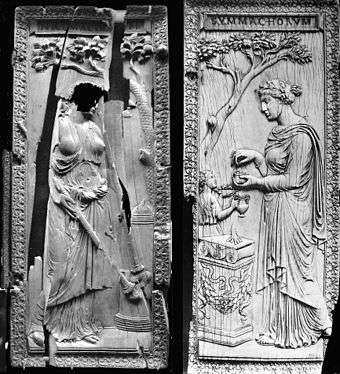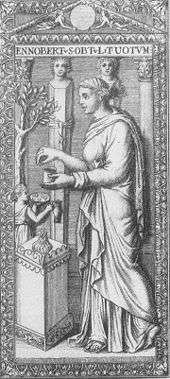Symmachi–Nicomachi diptych

The Symmachi–Nicomachi diptych is a Late Antique ivory diptych dating to the late fourth or early fifth century[1] whose panels depict scenes of ritual pagan religious practices. Both its style and its content reflect a short-lived revival of traditional Roman religion and Classicism at a time when the Roman world was increasingly turning to Christianity and rejecting the Classical tradition. The diptych takes its name from the inscriptions "Nicomachorum" and Symmachorum," references to two prominent Senatorial families. It was commissioned by the family of Q. Aurelius Symmachus, "one of the paladins of the pagan cause in the last quarter of the fourth century".[2]
Provenance
The diptych leaves were preserved together until the nineteenth century.[3] The earliest description of the leaves dates to 1717, when a treasury inventory of the monastery of Montier-en-Der records them serving as doors on an early thirteenth century reliquary.[4] Art historian and scholar Richard Delbrueck uncovered a reference to the panels in the abbot Adso's tenth century biography of Bercharius, who founded the monastery ca. 670. Adso wrote that his predecessor "visited Jerusalem and obtained very many sacred relics, and he brought back with him excellent tablets of ivory."[5] When the events of the French Revolution forced the closure of the monastery in 1790, the reliquary and its panels were temporarily lost. The Nicomachi wing was recovered in 1860 from a well, heavily damaged by fire, and the mostly intact Symmachi panel resurfaced in the hands of a collector not long after. They were subsequently acquired by the Musée de Cluny and the Victoria and Albert Museum respectively.
Description
The diptych was produced in Rome sometime between 388 and 401,[3] or in Milan, by the identical border details in the ivory panel of the Maries at the Tomb.[6] The Nicomachi panel measures 29.9 x 12.6 cm, that of the Symmachi 29.8 x 12.2 cm. Both wings depict female figures engaged in religious ritual before sacrificial altars. The Nicomachi tablet in Paris is by far the less well preserved of the pair, having sustained considerable damage in a fire. The ivory is fractured in several places, with some sections of the panel missing completely, together with high-relief areas such as the female figure's face, left hand and right arm. This figure stands before a round altar, holding two lit torches now partially missing. Cymbals hang from a pine tree overhead; both the tree and its hangings are attributes of the goddess Cybele and her consort Attis.[7]
The Symmachi leaf in London features an ivy-crowned woman sprinkling incense over the flames of a square altar garlanded with oak wreaths. A small attendant holding a kantharos and a bowl of fruit assists her. The oak garlands together with the oak tree overhead suggest the worship of Jupiter, while the ivy leaves recall the god Dionysus.[8] The female figures have been variously interpreted as priestesses[8] and as goddesses.[9]
The panels are generally believed to celebrate the alliance through marriage of two senatorial families, the Symmachi and Nicomachi. The most likely candidates are the daughter of Senator Quintus Aurelius Symmachus and Nicomachus Flavianus, the son of his colleague and friend Virius Nicomachus Flavianus, although it has also been suggested that the panels may instead commemorate the marriage of Symmachus' son, Quintus Fabius Memmius Symmachus with the granddaughter of the aforementioned colleague.[8] Diptychs were often commissioned by leading Roman families to celebrate important events, most often the attainment of the consulship. The diptych form, at least originally, served as a pair of covers for wax writing tablets.
The work as a whole has been interpreted as a study in nostalgia: both style and content reflect the values and traditions of an era that was rapidly passing. Just as the majority of the Roman world had rejected polytheism in favor of Christianity, so too it left behind the techniques of proportion and perspective that characterised the art of its forebears.[10]

The lost Ennobertus diptych
A strikingly similar composition was to be seen in the Ennobertus ivory panel from a diptych, known now only from an engraving of 1719,[11] when it was in the collection of the abbé Fauvel, chaplain to Louis XIV.[12] The Frankish name Ennobertus inscribed beneath the temple's pediment is undocumented in the prosopographies. To those who might have suggested the panel was a forgery after the Symmachi ivory, Alan Cameron has asked, "Why should he have spoiled his handiwork with such an uncouth barbarian name?" and suggested that it was a Late Antique ivory, from the same workshop as the Symmachi diptych, that had been re-engraved in Carolingian times, when the prominent blank medallion was cleaned of its former monogram.[13]
Notes
- ↑ Compare the Poet and Muse diptych of a hundred years later.
- ↑ Alan Cameron, "A New Late Antique Ivory: The Fauvel Panel", American Journal of Archaeology 88.3 (July 1984), pp. 397-402.
- 1 2 Weitzmann, 186.
- ↑ Kinney, 458; they were engraved for E. Martène and U. Durand, Voyage littéraire de deux religieux Bénédictins de la congregation de S. Maur (Paris, 1717, p. 98, noted in Cameron 1984, p. 387 note 5, below
- ↑ Delbrueck's view and Adso quotation found in Kinney, 461.
- ↑ This connection was made by Dale Kenney, "The workshop of the Trivulzio Master and Roman classicism, c 400" read at Seventh Annual Byzantine Studies Conference: Abstracts (Boston, 1981) p 55.
- ↑ Simon, 56.
- 1 2 3 Weitzmann, 187.
- ↑ Simon, 58.
- ↑ Kitzinger, 34.
- ↑ Bernard de Montfaucon, L'Antiquité expliquée et representée en figures (Paris, 1719), vol 2.1p. 190.
- ↑ Cameron 1984.
- ↑ Cameron 1984 p. 398, 400ff; the underappreciated Carolingian practice of reinscribing antique ivories is examined by K. Weitzmann, "The Heracles plaques of St. Peter's Cathedral", Art Bulletin 55 (1973), pp 25-29.
References
- Kinney, Dale; Cutler, Anthony (July 1994). "A Late Antique Ivory Plaque and Modern Response". American Journal of Archaeology. Archaeological Institute of America. 98 (3): 457–472. ISSN 1939-828X. JSTOR 506439. OCLC 51205117.
- Kitzinger, Ernst (1977). Byzantine Art in the Making: Main Lines of Stylistic Development in Mediterranean Art 3rd-7th Century. Cambridge, Massachusetts: Harvard University Press. ISBN 0674089561.
- Simon, Erika (April 1992). "The Diptych of the Symmachi and Nicomachi: An Interpretation". Greece & Rome. 39 (1): 56–65. doi:10.1017/S0017383500023986. ISSN 0017-3835. JSTOR 643120. OCLC 51206579.
- Weitzmann, Kurt (1979). Age of Spirituality: Late Antique and Early Christian Art, Third to Seventh Century. Catalogue of the exhibition at the Metropolitan Museum of Art, November 19, 1977, through February 12, 1978. New York: The Metropolitan Museum of Art. ISBN 0870991795.
| Wikimedia Commons has media related to Symmachi-Nicomachi diptych. |
